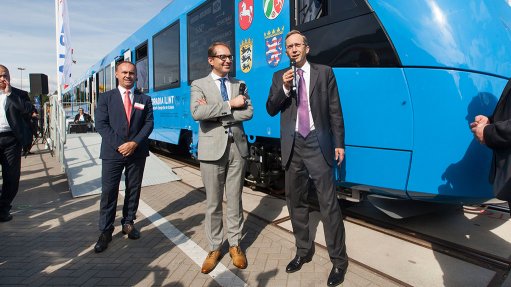
Coradia iLint
Two years after inking the first letters of intent (LoIs) with various German states and entities, French multinational Alstom’s zero-carbon-dioxide- (CO2) emission passenger train is set to grace the European country’s rail network.
Launched on Tuesday at railway trade fair InnoTrans, in Berlin, Germany, the new Coradia iLint locomotive is being promoted as a hydrogen-fuel-cell-powered alternative to diesel-powered locomotives and a more cost-effective choice compared to the electrification of lines.
Germany would be Alstom’s launching pad on route to the delivery of lower CO2 emission products, Alstom chairperson and CEO Henri Poupart-Lafarge said at a press briefing on the sidelines of the trade show.
The move forms part of the company’s commitment to cut the energy consumption of its solutions by 20% by 2020 and is a part of the solutions Germany will adopt with its commitment to reduce its CO2 emissions by 40% from a 1990 baseline in the next four years.
“Germany is the ideal starting point for hydrogen technology, as customers increasingly demand innovative and environment-friendly products and the transport authorities push for the implementation of regional emission-free transport technologies,” Poupart-Lafarge commented.
He pointed out that a significant portion of Europe’s rail network – 50% in the case of Germany, with some 20 000 km of nonelectrified track – remains nonelectrified, with the number of diesel locomotives operating still high.
LoIs were signed in 2014 with the German states of Lower Saxony, North Rhine-Westphalia and Baden-Württemberg, as well as with the Public Transportation Authorities of Hesse, for the development of a fuel-cell train.
An LoI was also concluded with the town of Calw in 2015.
“The only exhaust is water steam and condensed water. No greenhouse gases or particles are exhausted from the train and electricity is produced without any generator or turbine, which makes the process much quicker and more efficient,” Poupart-Lafarge added.
In a fact sheet outlining the features of the new train, Alstom highlighted the use of high-performance lithium-ion batteries for the storage of energy from the fuel cell when not in use.
“The battery stores energy from the fuel cell when not needed for traction or from the kinetic energy of the train during electrical braking and allows supporting energy delivery during acceleration phases. They accumulate the energy not immediately used in order to later supply it as needed.”
Coradia iLint, which is based on the diesel train Coradia Lint 54, will be manufactured at Alstom’s Salzgitter site, in Germany, with the first of the new trains scheduled to enter commercial service in 2018.
Natasha Odendaal is a guest of Alstom at InnoTrans.